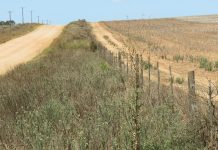
SA Graan/Grain contributor
Grains, including wheat, constitute some of the most important crops in the world. Over many years investment in breeding programmes has led to the development of grain varieties boosting higher yields with specific quality traits.
Genetic improvement and innovations in plant breeding are vital for continuous improvement in crop yields, seed, and grain quality, as well as for breeding resistance to pests and diseases in the face of climate changes.
For many years, yields of self-pollinated crops in South Africa have lagged behind that of other global production areas. Seed companies have been hesitant to release new varieties in the South African self-pollinating crop market. The high percentage of farm-saved seed has prevented seed companies from selling sufficient seed to justify additional investment in breeding and technology.
Who is SACTA?
The South African Cultivar and Technology Agency (SACTA) was created in 2016 to collect and administer breeding and technology levies for self-pollinated crops in South Africa.
SACTA is not linked to a specific commodity and addresses only the need to advance breeding of self-pollinated grain and oil seeds by collecting a levy at the first point of sale or delivery and by paying breeding and technology levies to seed companies and holders of plant breeder rights based on estimated market shares.
With the establishment of SACTA, industry found a novel, fair and sustainable value capturing system to fund technology and cultivar development in open-pollinated crops and to drive innovation down the entire value chain.
The levy is enabling breeding programmes to afford access to new sources of germplasm, bio-technology, better equipment, tools, and infrastructure and to participate in the value chain with international expertise.
‘The SACTA breeding and technology levy should be seen as a method to drive innovation in the value chain and an investment into the sustainability of the grain market in South Africa. It is aimed at driving farmer profits and crop productivity. The system is benefitting the entire value chain – the farmer with new germplasm and technology, the seed suppliers are receiving an income to reinvest in breeding and the downstream value chain is benefitting with improved grain and more local material. With new varieties and technology, local producers are now better equipped to compete with farmers in other world production areas,’ said Andrew Bennett, CEO of SACTA.
Some 75% of the collected fees are ploughed back into the seed industry by way of dividing the funds to the germplasm and technology owners in accordance with their market share.
General benefits of the levy
Maintaining the competitiveness of the grain market.
- Renewed investments into the local industry infrastructure by multinational as well as local seed business companies.
- Local breeding programmes now have better access to available international breeding material.
According to Dr Lukeshni Chetty, general manager at SANSOR (South African National Seed Organisation), the SACTA levy aims to ensure that companies have funds to allocate to varietal development and/or to access new varieties from other sources.
‘It is about a return on investment for open-pollinated crops where farm-saved seed is the norm. While paying the levy, farmers are still allowed to save seed and use it on their own land. It does not, however, provide for farmers to sell the farm-saved seed. This is very important. Should a farmer wish to sell farm-saved seed, he/she must be registered with the Department of Agriculture, Land Reform and Rural Development (DALRRD) as a seed seller to ensure they have the proper licence agreement with the intellectual property (IP) rights holder,’ she explained.
‘For wheat we are definitely seeing new entrants into the South African seed industry bringing new genetics to the table. Since the inception of the wheat breeding and technology levy in 2018, we have seen more than 65 new wheat varieties being registered. With the two additional wheat seed companies that have entered the market in the past year, we are expecting additional registrations of new varieties shortly,’ Dr Chetty pointed out.
Seed company perspectives
According to Dr Francois Koekemoer, head of research for Syngenta’s Seed Business in sub-Saharan Africa, the question one should ask is where seed companies would have been if they did not share in the money collected through the SACTA levies. ‘If we did not receive the funds from SACTA, we would not have been able to re-invest in our wheat breeding programme and infrastructure that allow us to improve our data collection and verification processes. The only outcome that I can think of in such a scenario, is stagnation of our entire industry,’ he said.
Traditionally wheat is not the leading staple crop in sub-Saharan Africa, but population growth and urbanisation have changed food preferences with a growing demand for wheat as an important part of the African food basket.
But, according to Dr Koekemoer, although the demand for these crops in the rest of Africa has increased, there are still no local breeding programmes. ‘Apart from South Africa, across the continent, seed companies and government are only testing varieties. There are no local breeding programmes as the cost of these programmes is too high in relation to the income derived from the sale of seeds.’
He added that without SACTA, this would have been the same in South Africa. ‘If we were not able to re-invest in our infrastructure and programmes, we would not have been able to drive our own breeding programme and would only have been able to test breeding material from elsewhere in the world.’
According to Hendrik van Staden, Syngenta Seeds business unit head in sub-Saharan Africa, another benefit is the fact that there are more role-players in the market. ‘More role-players imply that there are more products on the market that provide farmers with an increased product choice. In a way this puts pressure on companies to ensure that our products not only comply to quality standards, but also address specific market needs. Competition in the market is always a good thing. It keeps us on our toes and – in the end – this is to the benefit of farmers and the industry as a whole.’
Another benefit from the SACTA investments, according to Dr Koekemoer, pertains to data. ‘We are now able to plant more small-plot and commercial trials that generate more data points from which information can be extracted with a view to choosing varieties to put in the pipeline, as well as for recommendations to farmers.’
Van Staden pointed out that the development, release, and use of new wheat varieties were based on many factors. First of these, according to him, is that new varieties should adapt to and address a diversity of environmental conditions, production practices, and market needs.
Secondly, yields must be protected and stabilised through disease resistance. ‘Disease resistance can stabilise yields and reduce economic losses. For farmers that already face many challenges such as increased costs of fertiliser and crop protection products, every cent that we can help save, will make a difference on their profit margins.’
Diseases contribute to the factors that limit the possibility of achieving increased yields on the one hand and decrease quality on the other hand. Out of a documented list of 200 diseases and pests of wheat, some 50 are considered to be significant (Randhawa et al., 2019).
Dr Koekemoer explained that disease resistance in varieties has the possibility to slow pathogen spread and multiplication, thereby prolonging the life of available active ingredients used in crop protection. ‘In addition, the growing use of conservation tillage and soil health practices has highlighted the importance of control of diseases such as Fusarium head blight and wheat rust.’
He added that the country was in a lucky position that the SACTA levy played a major role in enabling Syngenta to breed resistance against the new yellow rust strain in its varieties. If this had not been done, the impact on the wheat market would have been disastrous.
Also, he alluded to the fact that the SACTA levy enabled Syngenta to develop new varieties such as SST 0166, SST 0187 and SST 0208 for the Western Cape market and SST 8205 for the irrigation market. ‘With the funds made available, we were able to re-invest in our breeding programme and advance new products that will set new benchmarks in the market.’
According to John Odendaal, Pannar business manager, the company launched its wheat breeding programme in 1988. ‘Given the country’s volatile and often dry climatic conditions, the wheat breeding programme has always been focused on yield and stability to benefit the farmer,’ he explained.
‘Post 2013, as a consequence of a high percentage of farmer retention of grain for seed as well as the historically low profit margins associated with open-pollinated crops, we as industry expressed the need for an alternative model that would generate sufficient income from all planted wheat hectares, both bought and retained seed, that would enable sustainable breeding efforts and ensure ongoing genetic improvement. This was the inception of an end-point royalty system and ultimately SACTA,’ Odendaal pointed out.
He stressed that the end-point royalty system had opened the doors to more advanced breeding and producers have already experienced the benefits of new varieties.
‘Pannar will continue to invest in new genetics and is well positioned to support farmers with new technology going forward. Without the support of SACTA and the intellectual property laws in South Africa, Pannar would not be able to invest in new research and development to keep farmers competitive,’ he said.
Reference
- Randhawa, MS, Bhavani, S, Singh, PK, Huerta-Espino, J & Singh, RP. 2019. Disease resistance in wheat: Present status and future prospects. Disease Resistance in Crop Plants: Molecular, Genetic and Genomic Perspectives, pp.61-81.




























